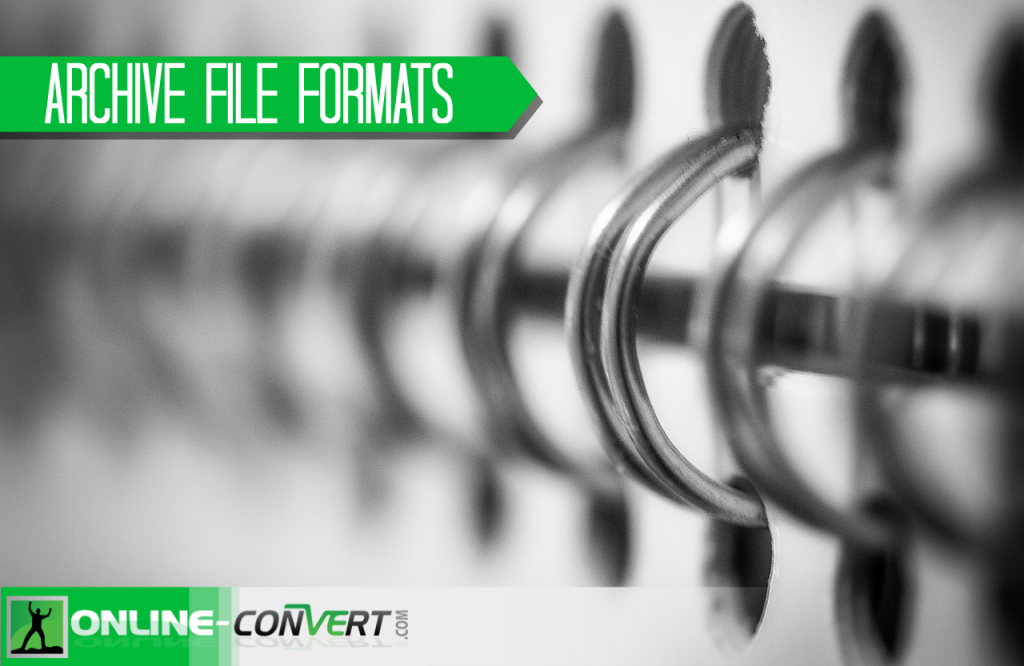
In the past, we at Online-Convert.com have given you many information about different raster and vector image file formats. We talked about all kinds of lossy and lossless audio files as well as e-book files that are compatible with particular e-reading devices. Different kinds of document files and video containers and codecs have been discussed here as well.
One particular file type, however, is missing. Until today!
Lets have a look at all the different archive file formats, the compression methods they use and more!
Popular Archive File Formats
The list of different compressed archives is long. There are approximately 250 known archive formats, but the number is probably even higher since many programs use their own compressed files for packaging. The ones we look at here are the most common and widely used archive files you will find on the web.
7Z
7Z archives are one of the most versatile archive files. They have been called “future proof” since they were compatible with new compression software as well as with the old ones that came out when the format was released in 1999. 7Z archives support many different types of compression (e.g. LZMA, PPMD, BCJ, Bzip2, Deflate) and encryption (e.g. AES-256), as well as pre-processing algorithms. It is most commonly associated with the 7-Zip compression program. Both the program and the file format are open source – something that may be a usage criteria for many.
| Advantages | Disadvantages |
|
|
TAR.BZ2
TAR.BZ2 files use a form of TAR archiving. TAR itself is a function that creates archives only without applying any compression. Here, bzip2 compression (Burrows-Wheeler algorithm) is used to turn these TAR archives into BZ2 compressed archive files. Just like 7Z, TAR.BZ2 was licensed under the open standard license, and it’s compression method is, while not as good as 7Z, highly advanced in comparison to, e.g. ZIP or TAR.GZ archives.
| Advantages | Disadvantages |
|
|
TAR.GZ
Similar to TAR.BZ2, TAR.GZ files combine TAR archiving with a gzip compression method to compress the TAR archive. Like the previously mentioned archive files, TAR.GZ files belong to the open standard and is most commonly used on Unix systems. The gzip compression is based on the DEFLATE algorithm, which results in lower compression rates in comparison. However, the compression speed is the highest compared to common archive formats.
| Advantages | Disadvantages |
|
|
RAR
Rivaling the well-known ZIP archive when it comes to popularity, RAR is another wide-spread archive format. In direct comparison to ZIP, however, RAR archives have the better compression rate. The RAR file format is not licensed under open source licensed, but can easily be compressed and decompressed with the free program WinRAR for Windows andcomparable software for Mac OS X as well as Linux.
| Advantages | Disadvantages |
|
|
ZIP
The most common and wide-spread archive format is, without a doubt, ZIP. ZIP files are very versatile. They can either use as pure archiving files that group files togetherwithout compressing them, or compress single or multiple files into one ZIP file. Thanks to the compression being applied to each single item, ZIP compression makes sure that each file type is compressed in the best possible way. The most commonly used compression methods is DEFLATE, but others can be applied as well (BZip, LZMA, PPMD and more).
| Advantages | Disadvantages |
|
|
ZIPX
ZIPX files are the “new and improved” version of the widely used and popular ZIP file. It has been introduced with WinZip 12.1 and uses an extended compression method. The compression rates are higher than those of “regular” ZIP files, but on the expense of compression speed which is quite slow.
| Advantages | Disadvantages |
|
|
Comparing these archive files correctly, one can draw the following, rough comparison between the files:
Compression Rate
7Z > RAR & ZIPX > TAR.BZ2 > TAR.GZ > ZIP
Compression Speed
ZIP & TAR.GZ > RAR & TAR.BZ2 > 7Z & ZIPX
